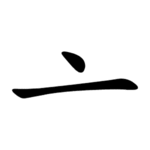| 亠 | ||
|---|---|---|
| ||
| 亠 (U+4EA0) "lid, head" | ||
| Pronunciations | ||
| Pinyin: | tóu (=頭/头) | |
| Bopomofo: | ㄊㄡˊ | |
| Gwoyeu Romatzyh: | tour | |
| Wade–Giles: | tʻou2 | |
| Cantonese Yale: | tàuh | |
| Jyutping: | tau4 | |
| Pe̍h-ōe-jī: | thâu (col.) thô͘ (lit.) | |
| Japanese Kana: | トウ tō ( on'yomi) | |
| Sino-Korean: | 두 do | |
| Names | ||
| Chinese name(s): | 點橫/点横 diǎnhéng 文字頭/文字头 wénzìtóu | |
| Japanese name(s): | 鍋蓋/なべぶた nabebuta 卦算冠/けいさんかんむり kēsankanmuri | |
| Hangul: | 자의미상 jauimisang | |
| Stroke order animation | ||
 | ||
Radical 8 or radical lid (亠部), whose meaning as an independent word is unknown, but is often interpreted to be a " lid" when used as a radical, is radical 23 of the 214 Kangxi radicals and consists of two strokes.
In the Kangxi Dictionary, there are 38 characters (out of 49,030) to be found under this radical.
亠 is also the 17th indexing component in the Table of Indexing Chinese Character Components predominantly adopted by Simplified Chinese dictionaries published in mainland China.
Evolution
-
Small Seal Script character
Derived characters
| Strokes | Characters |
|---|---|
| +0 | 亠 (component only) |
| +1 | 亡 |
| +2 | 六 卞 亢 亣 |
| +4 | 交 亥 亦 产SC (= 產 -> 生) |
| +5 | 亨 亩SC (= 畝 -> 田) 亪 |
| +6 | 享 京 |
| +7 | 亭 亮 亯 亰 (=京) 亱 (= 夜 -> 夕) 亲SC (= 親 -> 見) |
| +8 | 亳 |
| +10 | 亴 亵SC (= 褻 -> 衣) |
| +11 | 亶 亷 (= 廉 -> 广) |
| +14 | 亸SC (= 嚲 -> 口) |
| +19 | 亹 |
Variant forms
There is a difference in Japanese and Chinese in printing typefaces for this radical. Traditionally, a short vertical line on top of the horizontal line was used in printing, while a slanted dash is preferred in handwriting.
The vertical dot form is used in the Kangxi Dictionary, modern Japanese and Korean typefaces. In Mainland China, Taiwan, and Hong Kong, a slanted dot on top of the horizontal line is the standard form, though the traditional form with a vertical dot is also widely used in Traditional Chinese typefaces and in some cases Simplified Chinese typefaces.
Both forms are acceptable in handwriting in each language.
| Kangxi Dictionary Japan Korea |
Mainland China Taiwan Hong Kong |
|---|---|
| 亠 | 亠 |
Literature
- Fazzioli, Edoardo (1987). Chinese calligraphy : from pictograph to ideogram : the history of 214 essential Chinese/Japanese characters. calligraphy by Rebecca Hon Ko. New York: Abbeville Press. ISBN 0-89659-774-1.
- Leyi Li: "Tracing the Roots of Chinese Characters: 500 Cases". Beijing 1993, ISBN 978-7-5619-0204-2
